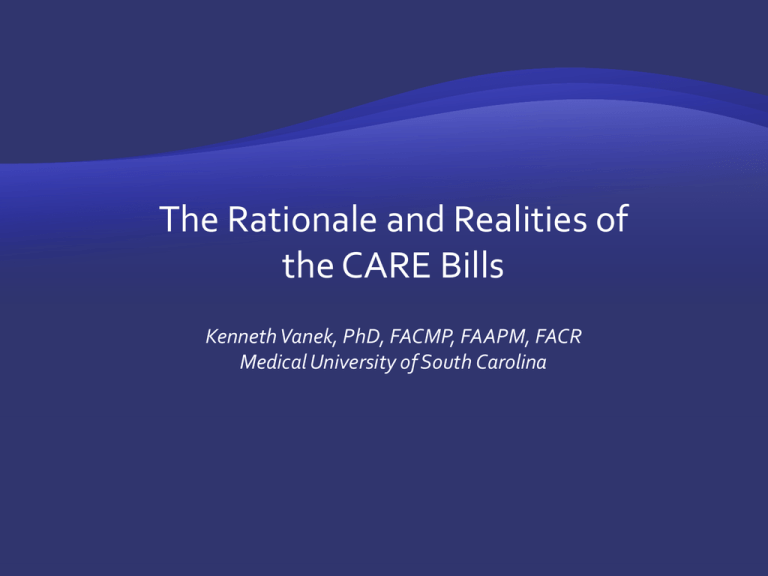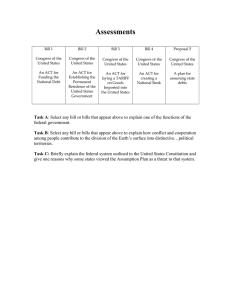The Rationale and Realities of the CARE Bills
advertisement

The Rationale and Realities of the CARE Bills Kenneth Vanek, PhD, FACMP, FAAPM, FACR Medical University of South Carolina Discuss rationale behind the Care Bill Discuss its importance to our profession Review the legislative history of the CARE Bill Review its current status Review subsequent actions that we need to take Stimulate discussion about training of medical physicists, licensure issues, and advocating our profession. Christine Lung – ASRT Director of Government Relations Herb Mower – ACMP co-representative to the Alliance David Keys – AAPM Co-representative to the Alliance Jerry White - AAPM Co-representative to the Alliance Lynne Fairobent – AAPM Legislative and Regulatory Affairs Manager Friedson’s classic characterization of a profession “an occupation that controls its own work organized by a special set of institutions sustained in part by a particular ideology of expertise and service” Friedson, E Professionalism Reborn. Cambridge:Polity Press, 1994 Friedson’s classic characterization of a profession “an occupation that controls its own work organized by a special set of institutions sustained in part by a particular ideology of expertise and service” Friedson, E Professionalism Reborn. Cambridge:Polity Press, 1994 Education (Academic degrees) Certification Credentialing Registration Licensure The process by which a non-governmental (voluntary) agency or organization grants recognition of competence to an individual who has met certain predetermined qualifications specified by that national agency or organization American Board of Radiology American Board of Medical Physics American Board of Science in Nuclear Medicine American Board of Health Physics Canadian College of Physicists in Medicine The recognition of professional or technical competence. The credentialing process may include approval to perform specific procedures. It is generally based on training, certification, and experience in a general area. Medical physicists are rarely included in the hospital credentialing process. Anyone can provide medical physics services as long as State regulations are met The process by which “qualified individuals” are listed on an official roster maintained by a government agency or certifying body. Several states have a limited registration process especially for individuals providing medical physics services outside of their principal employment. Requirements for registration vary widely among the States The process whereby a government agency grants permission to an individual to engage in a given occupation upon finding that the applicant has met predetermined qualifications and has attained the minimal degree of competence necessary to insure that public health, safety, and welfare will be reasonably protected. Unqualified individuals pose a hazard to the general public The general public is unable to adequately determine an individual’s competency. Licensure is a legal requirement to practice Penalties for practicing without a license www.aapm.org/government_affairs/licensure Why not licensure in more States ? Small number of medical physicists in each State Much smaller number, if any, willing to devote the time and effort into licensure Limited political funds and political influence No large national organization leading aggressive licensure campaign Care Bill ≠ Licensure Bill What do the Care bills really do? Set education and credentialing standards for ALL persons performing medical imaging, planning and delivering radiation therapy The federal government would provide minimum standards in 42CFR75 Each individual State would then have to decide how to implement and enforce these minimum guidelines Personnel standards are a condition of participation in Medicare, Medicaid, Public Health Service and all programs under the jurisdiction of the Department of Health and Human Services. HHS has 36 months to ensure all programs are in compliance and can withhold payment after 48 months. Alternative standards for rural areas. Had to remove specific reference to each specialty (cardiovascular tech concerns, then dental assistants, etc) Important that members of Congress specifically mention medical physics in the hearing procedures to firmly establish that it is the intent of Congress to include medical physics in this bill Pros: Closely parallels federal standards for other allied health professionals. Liked by all affected imaging professions. Includes sonography. Cons: Does not require state licensure. Standards enforced by employers (hospitals, MD offices) who want federal reimbursement. States would not be able to prosecute for non-compliance. Not all States require ABR (or other) certification to practice medical physics Establish National Minimal Education and Training Requirements “Safeguard “ our professional interests Legislative History In July 1998, the ASRT and the SNM technologist section founded the Alliance for Quality Medical Imaging and Radiation Therapy to promote their national licensure effort Initially, the ACMP and AAPM just financial contributors to the Alliance After the second House bill had almost finished being drafted, ACMP then AAPM requested that medical physics be added to the bill Why did physicists join forces with radiologic technologists? The ability of RTs to safely deliver radiation is certainly dependent upon the physicists doing their job well AAPM and ACMP membership and financial resources are small. AAPM and ACMP have limited political influence ACR will not initiate such a federal level effort for its small physics contingency (735/635) Safeguard our professional interests 20 Radiologic Science Organizations Over 750,000 members 2000 (106th Congress) Sep 26th Introduced Rep. Rick Lazio (R-NY). The bill died when Congress adjourned. 2001 ( 107th Congress) February - Medical physics joined the Alliance late in the wording of the bill March 14 - Introduced by Rep. Heather Wilson (R-NM) Included Medical Physicists and Dosimetrists 2002 – The bill died when Congress adjourned. 2003 (108th Congress) March 11 - Introduced by Rep. Heather Wilson (R-NM) June 5 - Senate Bill Introduced by Mike Enzi (R-WY) 2004 The bills died when Congress adjourned. 2005 ( 109th Congress) March 18 – Introduced by Rep Chip Pickering (R-MS) Referred to the House Energy & Commerce Committee, Health Subcommittee. 2006 (last year of the 109th Congress) Feb 17 – Senate bill introduced by Senators Enzi (R-NV) and Kennedy (D-MA) The bills died when Congress adjourned. 2007 (110th Congress) Jan 19 – HR 583 introduced by Rep. Mike Doyle (D-PA) Mar 29 - S. 1042 introduced by Senators Enzi (R-NV) and Kennedy (DMA) BOTH bills are identical 2008 ( Last year of the 110th Congress) Feb 27 – HR 583 mark up – 132 cosponsors Mar 13 – S 1042 passed Health, Energy, Labor, and Pensions (HELP) Committee to Senate Finance Committee who has been charged with ensuring that there is a financial incentive for the Secretary of HHS to enforce the standards they develop – 24 cosponsors HR 583 – 149 Sponsors ( 96 Democrats 53 Republicans) S1042 - 27 Sponsors ( 8 Democrats 17 Republicans 2 Independent) www.asrt.org/content/GovernmentRelations/CAREBill/cosponsors Get the bill out of the Senate Finance Committee to the floor Pass both bills Both bills are identical so a compromise will not be needed Medical Physics organizations need to get aggressive in supporting the Care Bill and RadCare Bills. Active campaign to promote both bills AND to emphasize importance of medical physics We need to become politically active and form grass roots teams in each State Once the bills have been passed and the Secretary has developed the regulations, then the effort moves to the States for implementation We MUST be active in the State process With 2008 being a Presidential election year, the “active” Congressional year is basically over Very few bills will be enacted between now and Jan 1 Senator Kennedy was a major promotor of the Senate Bill is sidelined with his health problems Congress operates on a system of trade-offs or what’s in it for me? “It” may mean Money Campaign contributions Funds for political district & pet projects Face time Constituent Votes Exchange of Votes on Other Issues The CARE Bill does not have an aggressive champion With no champion and no major grass roots activists, there is no high visibility Congress depends upon the apathy of voters If there is no public outcry or significant interest, then there is no problem The last request for writing your Congressional representative resulted in less than 200 letters from AAPMs 6000+ membership Although the Alliance has 750,000 members, a vast majority of them come from States that already have licensure for RTs and RTTs so interest is lacking H.R. 6331 (the Medicare Improvements for Patients and Providers Act of 2008) recently passed increase in physician payments The HHS Secretary must set accreditation standards for “advanced diagnostic imaging modalities” The facility accreditation standards for these modalities must contain standards for technical personnel performing these procedures. H.R. 6331 excludes standards for imaging procedures using radiography (x-ray and fluoroscopy) sonography (including echocardiography) standards for radiation therapy procedures. These exclusions make up more than 70% of the imaging procedures provided to Medicare recipients Impact on CARE Bill ??? The AAPM is celebrating it’s 50th Anniversary this year Scientifically, we are mature Politically and professionally, however, we are adolescents Why? Except for a small nucleus of members, individually and organizationally, we have not fully recognized the fact that we must take control of our profession and protect it Education & training requirements Licensure Other needed efforts Political lobbying – grass roots organization State and Federal lawmakers Government agencies Professional lobbying ACR ASTRO Insurance agencies Practice accreditation The technology explosion is giving us an opportunity to firmly implant the importance of our profession in the clinical setting The BIG question is “Will we take advantage of this opportunity?” Your professional future


